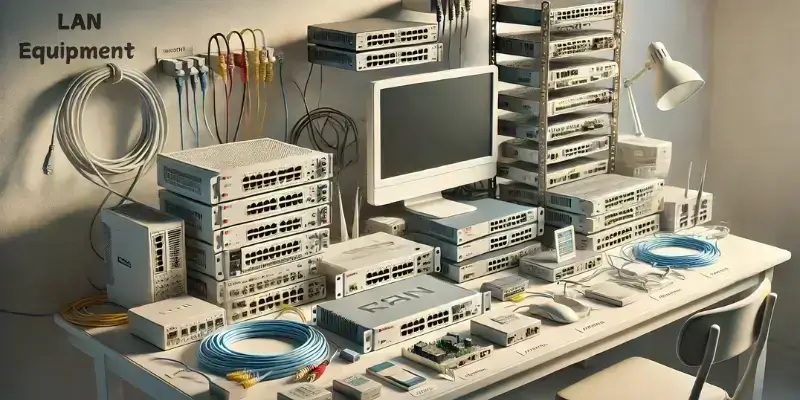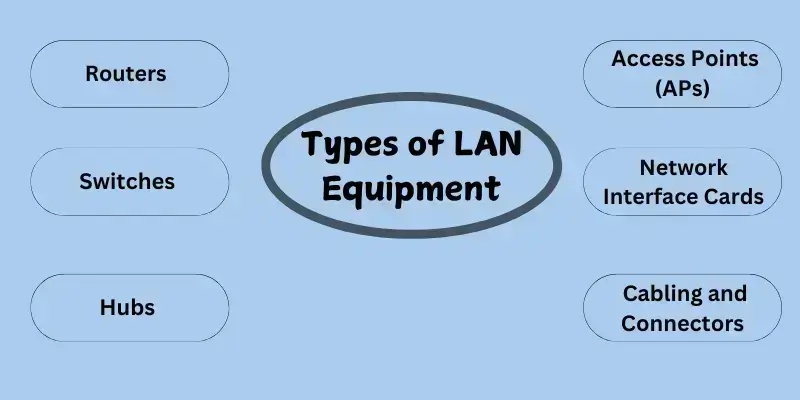LAN Equipment: Essential Devices for Fast Networking
Published: February 6, 2025
In networking, a Local Area Network (LAN) connects multiple devices within a limited area, like a home, office, or campus. LANs allow devices to communicate with each other and share resources such as files, printers, and internet connections. To make this communication possible, various types of LAN equipment are required.

Importance of LAN Equipment in Networking
LAN equipment plays a crucial role in a LAN’s setup, functioning, and management. Here are some reasons why LAN equipment is essential:
1. Connectivity
LAN equipment connects various devices like computers, printers, and servers, enabling them to communicate efficiently.
2. Resource Sharing
It allows devices to share resources like files, applications, and internet access, making the network more efficient and cost-effective.
3. Performance
The right equipment ensures smooth data transfer and minimizes bottlenecks, enhancing the overall network performance.
4. Security
LAN equipment such as firewalls, switches, and routers can help protect the network from unauthorized access and threats.
5. Scalability
LAN equipment can be upgraded or expanded to meet growing demands as the need for more devices or higher speed increases.
Types of LAN Equipment
A Local Area Network (LAN) relies on various equipment to ensure smooth connectivity, communication, and data transfer. Below are the main types of LAN equipment:

1. Routers
Role of Routers in LAN
Routers connect different networks, such as connecting a local network to the internet. They also direct traffic between devices within the LAN, ensuring that data is sent to the correct destination.
Types of Routers
Wired Routers
These routers require physical cables (such, Ethernet) to connect to the network. They are ideal for stable, high-speed connections in office environments.
Wireless Routers
These routers allow devices to connect wirelessly (Wi-Fi). They are commonly used in homes and offices where mobility and ease of setup are essential.
2. Switches
What Switches Do in LAN
Switches manage LAN traffic by directing data packets to specific devices. Unlike hubs, switches are more efficient as they send data only to the intended recipient, reducing network congestion.
Types of Switches
Managed Switches
These provide more control over the network. They can be configured to optimize traffic flow, enhance security, and enable remote monitoring.
Unmanaged Switches
These are simpler and cheaper, offering plug-and-play functionality without configuration. They are typically used in smaller networks where complex management is not necessary.
3. Hubs
Difference Between Hubs and Switches
A hub is an essential networking device that broadcasts data to all devices on the network, which can cause data collisions and slower speeds as the network grows. In contrast, a switch sends data only to the intended device, reducing congestion and improving efficiency.
When to Use a Hub
Hubs are generally used in smaller, less demanding networks or for temporary connections where advanced traffic management isn’t necessary.
4. Access Points (APs)
Role of Access Points in Wireless LAN
Access points extend the range of a wireless network, allowing devices to connect to the LAN wirelessly. They act as bridges between wired and wireless segments of the network.
Types of Wireless Access Points
Standalone Access Points
These provide essential connectivity and are used in simple wireless network setups.
Controller-based Access Points
These are often used in large or enterprise networks where a centralized controller manages multiple access points for better performance and security.
5. Network Interface Cards (NICs)
Importance of NICs in LAN Connectivity
A Network Interface Card (NIC) is a hardware component that enables a device (such as a computer) to connect to a network. It can be wired (Ethernet) or wireless (Wi-Fi).
Wired vs. Wireless NICs
Wired NICs
These NICs use Ethernet cables to connect devices to the LAN, offering a stable, fast, and secure connection.
Wireless NICs
These allow devices to connect to the LAN without cables, providing more flexibility and mobility. However, they may have slower speeds or lower stability than wired connections.
6. Cabling and Connectors
a. Ethernet Cables
Cat 5e (Category 5e)
Supports speeds up to 1 Gbps and is commonly used for essential home and office networks.
Cat 6 (Category 6)
Supports higher speeds (up to 10 Gbps) and is ideal for networks that need higher performance or are future-proofing for higher speeds.
Cat 7 (Category 7)
Offers even higher speeds (up to 40 Gbps) and is often used in professional and high-demand environments where performance is critical.
b. Fiber Optic Cables
These use light to transmit data, offering high-speed connections over long distances. They’re used in high-performance networks or those requiring high security.
c. Connectors
RJ45
A standard connector is used in Ethernet cables for wired networking, ensuring the secure transmission of data between devices.
Other Connectors
Fiber optic cables may use LC, SC, or ST connectors, depending on the type of fiber and the network’s requirements.
Essential Features of LAN Equipment
Choosing the right equipment is crucial when setting up or upgrading a Local Area Network (LAN). The equipment should meet key features to ensure smooth operation and meet your network’s needs.
1. Speed and Bandwidth
Speed
This is how fast data moves within the network. Faster speeds allow quicker file transfers, smoother video streaming, and better overall performance. High-speed equipment like Gigabit Ethernet (1 Gbps) and 10 Gigabit Ethernet is ideal for faster data transmission.
Bandwidth
Bandwidth determines how much data can be sent at once. The higher the bandwidth, the more data can flow through the network simultaneously, which is essential for high-demand networks. Ethernet cables like Cat 6 support higher speeds and greater bandwidth, making them a good choice for busy networks.
2. Reliability and Stability
Reliability
The equipment must work consistently without interruptions. Devices like managed switches ensure data flows smoothly, even during peak usage. These devices help reduce network failures, providing reliable connectivity for users.
Stability
Stable equipment keeps your network running without sudden slowdowns or disconnections. Wi-Fi routers with the latest standards, such as Wi-Fi 6, ensure stable wireless connections even with multiple devices connected simultaneously.
3. Security Features
Data Protection
Security is key in any network. Equipment like routers and switches often has built-in firewalls to block unauthorized access. Encryption features on Wi-Fi routers (like WPA3) ensure that data is protected when it moves across the network.
Access Control
Managed switches allow Access Control Lists (ACLs), which define who can access certain network parts. This adds an extra layer of protection to sensitive data.
Authentication
Network equipment can include 802.1X authentication to ensure that only authorized devices and users can access the network. This is especially useful in larger, more secure environments.
4. Scalability (Expanding the Network)
Future-Proofing
As your network grows, you’ll need equipment that can scale with your needs. Managed switches allow you to add more ports, while routers can support higher traffic volumes, ensuring the network can handle more users and devices over time.
Wireless Expansion
In a wireless network, access points can be added to extend coverage as the network grows. Controller-based access points offer centralized management, making handling large networks more manageable.
LAN Equipment Configuration
Configuring LAN equipment correctly ensures the network operates smoothly, efficiently, and securely. Below is an overview of how to configure the most common LAN equipment.
1. Router Configuration
Basic Setup
The router connects your local network to the internet and manages the traffic between devices.
- IP Addressing
Each device on the network needs a unique IP address. Most routers have a Dynamic Host Configuration Protocol (DHCP) server that automatically assigns IP addresses to devices when they join the network.
- NAT (Network Address Translation)
This feature allows multiple devices within the local network to share a single public IP address when accessing the internet. It ensures efficient use of IP addresses and enhances security.
2. Switch Configuration
VLAN Setup and Management
A Virtual Local Area Network (VLAN) divides a physical network into smaller, isolated sections, improving performance and security.
- VLANs
VLANs are configured on managed switches. Each VLAN can have its rules for traffic flow, improving network efficiency.
- Management
Managed switches allow you to configure VLANs based on your network needs. For example, you can assign devices like printers and computers to separate VLANs for better organization and security.
Port Security and QoS (Quality of Service)
- Port Security
This feature limits which devices can connect to specific switch ports, preventing unauthorized access and improving security.
- QoS
This ensures that essential traffic (like voice or video) gets priority over less critical traffic (like email), helping avoid delays or interruptions for high-priority services.
3. Access Point Configuration
Wireless Security (WPA2, WPA3)
Wireless networks are vulnerable to unauthorized access, so securing your Wi-Fi network is essential.
- WPA2 (Wi-Fi Protected Access 2)
It’s a standard security protocol used for protecting wireless networks. It provides strong encryption but is considered outdated compared to the newer standard.
- WPA3
The latest security standard, WPA3, offers improved encryption and robust protection against hacking attempts. It’s recommended for modern networks.
SSID Settings and Channel Selection
- SSID (Service Set Identifier)
This is the name of your Wi-Fi network. When setting up your router or access point, choose a unique SSID so that users can quickly identify your network.
- Channel Selection
Wi-Fi operates on specific channels. To avoid interference, select the least crowded channel. Modern routers or access points often have an auto-select feature to choose the best channel.
LAN Equipment Use Cases
1. Small Office/Home Office (SOHO) Networks
Equipment
Router, unmanaged switch, access point, NICs.
Use Case
This is a simple setup for small networks with a few devices. The router manages internet access, and the switch connects wired devices. Wireless access points provide Wi-Fi.
Example
A 5-person design team using a router for internet, a switch for desktops, and an access point for Wi-Fi.
2. Enterprise Networks
Equipment
High-performance router, managed switches, wireless access points, firewall.
Use Case
Supports multiple departments and devices with VLANs, traffic prioritization, and secure remote access.
Example
A company with 100 employees using VLANs for security and managed access points for office-wide Wi-Fi.
3. Data Centers and High-Traffic Networks
Equipment
Core routers, high-capacity switches, fiber optic cables, servers.
Use Case
Handles high data volumes with low latency, using fiber optics and core switches for fast, secure connections.
Example
A cloud service provider’s data center uses fiber and core switches to manage massive data traffic securely.
Troubleshooting LAN Equipment
1. Common Issues
Connectivity Problems
Devices may fail to connect to the network due to incorrect IP settings or faulty cables.
Slow Speed
Slow network performance can be caused by overburdened switches, outdated equipment, or too many devices consuming bandwidth.
2. Tools for Diagnosing Problems
Ping
A simple tool to check if a device is reachable over the network. It helps identify if there’s a connectivity issue.
Traceroute
Traces the route data takes to reach a destination, showing where delays or failures occur.
Network Analyzer
Wireshark can capture and analyze network traffic to pinpoint slowdowns or errors.
3. Resolving Equipment Failures
Switch Issues
If switches fail, devices may not communicate. Try rebooting or replacing faulty cables. If the switch is managed, check the configuration settings.
Router Problems
A router failure may result in loss of internet access. Restart the router, check its connections, and update firmware. If issues persist, consider replacing the router.
Access Points
If Wi-Fi is down, reboot the AP, check signal strength, and ensure it’s on the correct channel. Also, verify that security settings are correct.
Future Trends in LAN Equipment
1. Evolution of Wireless LAN (Wi-Fi 6, Wi-Fi 7)
Wi-Fi 6
The latest standard for wireless networks offers faster speeds, increased capacity, and better efficiency in crowded environments. It allows more devices to connect without slowing down the network.
Wi-Fi 7
The upcoming standard promises even faster speeds and lower latency, enhancing support for high-demand applications like 4K/8K streaming and augmented reality (AR).
2. Advancements in Ethernet Technology
10GbE and Beyond
Ethernet speeds are increasing, with 10 Gigabit Ethernet (10GbE) and 100GbE becoming more common in enterprise and data center networks. These faster connections are crucial for handling large amounts of data and ensuring low latency in high-traffic environments.
3. Integration with IoT Devices
IoT Connectivity
As more IoT devices (smart home gadgets, wearables, industrial sensors) join networks, LAN equipment is evolving to support them. Switches and routers will increasingly integrate features like Power over Ethernet (PoE) for powering devices and IoT-friendly protocols to handle the massive influx of connected devices.
Conclusion
In conclusion, LAN equipment is essential for creating a network that connects devices efficiently and securely within a limited area. From routers and switches to access points and NICs, each piece of equipment plays a key role in ensuring smooth communication and resource sharing. I recommend investing in high-quality LAN equipment that matches your needs, whether for a small office or a large enterprise. However, always be mindful of compatibility and network demands to avoid potential issues. With the proper setup, you can future-proof your network and enhance performance. Dive deeper into LAN equipment options and optimize your network today for better connectivity and performance!
FAQs About LAN Equipment
LAN (Local Area Network) equipment includes devices like routers, switches, modems, and cables that help computers and other devices connect and share data within a small area, like a home or office. You need it to access the internet, share files, and connect devices efficiently.
No, a router and a modem are different. A modem connects your network to the internet, while a router distributes the connection to multiple devices wirelessly or through cables.
It depends on your network. A router is essential for internet access, but a switch helps connect multiple wired devices efficiently within the network, making it useful for larger setups.
A hub sends data to all connected devices, which can slow down the network. A switch is more intelligent—it transmits data only to the device that needs it, making the network faster and more efficient.
Yes, but LAN cables (Ethernet) provide a more stable and faster connection than Wi-Fi. Wi-Fi is convenient, but wired connections are better for gaming and video streaming tasks.
An access point extends Wi-Fi coverage by allowing more devices to connect wirelessly. It’s helpful in large homes or offices where a single router’s signal isn’t strong enough.
Routers have limited ports, usually four or five, while a switch adds more ports for connecting multiple wired devices. It is useful in offices or homes with many wired devices.
A better router can improve network speed and stability within your home, but it won’t make your internet faster than your provider offers. Your internet speed depends on your service plan.
These are Ethernet cables with different speeds and performance levels. Cat5 is older and slower, while Cat6 and Cat7 support higher speeds and less interference, making them better for modern networks.
Most routers have built-in firewalls that provide basic security. However, a separate firewall device can add more security features if you need extra protection for business networks or sensitive data.





